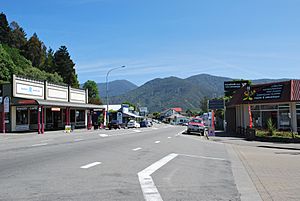Havelock, New Zealand facts for kids
Quick facts for kids
Havelock
|
|
|---|---|
|
Town
|
|

Havelock seen across Pelorus Sound
|
|
| Region | Marlborough |
| Ward |
|
| Electorates |
|
| Area | |
| • Total | 1.76 km2 (0.68 sq mi) |
| Population
(June 2023)
|
|
| • Total | 640 |
| • Density | 364/km2 (942/sq mi) |
Havelock is a small town in the Marlborough Region of New Zealand. It sits at the top of Pelorus Sound, which is one of the beautiful Marlborough Sounds. The Pelorus and Kaituna Rivers also meet the sea here.
The main road, State Highway 6, goes through Havelock. This road connects Nelson to Blenheim. Another road, Queen Charlotte Drive, offers a shorter but winding path to Picton. Havelock is about 10 kilometers (6 miles) from Canvastown and 35 kilometers (22 miles) from Picton.
Havelock is known as the "greenshell mussel capital of the world." It's a major center for New Zealand's green-lipped mussel farming. The town is also a busy base for fishing boats and recreational boats. A special mail boat leaves from Havelock to deliver mail to people living in remote parts of the Marlborough Sounds.
The town was named after Sir Henry Havelock, a British general. He was famous for his role in the Siege of Lucknow in India in 1857. The streets were planned in 1858, with Lucknow Street becoming the main road.
In 1864, a gold rush in the Wakamarina Valley helped Havelock grow. Sawmilling, which is cutting timber, became the main business until the 1910s. Later, dairy farming also became important. Today, you can see many pine tree farms in the valleys around Havelock.
If you enjoy walking, you can explore the Cullen Point Scenic Reserve. It's across the Kaituna River estuary. This reserve has a coastal walking track that leads to a lookout point at Cullen Point.
People Living in Havelock
Havelock is a small community. In 2018, about 588 people lived here. There were 234 households, with slightly more males than females. About 14% of the people were under 15 years old.
Most people in Havelock are of European descent (83.7%). About 15.8% identify as Māori. People can identify with more than one ethnic group.
When asked about religion, most people (58.7%) said they had no religion. About 26.5% were Christian.
Education in Havelock
Havelock School is a school for students from Year 1 to Year 8 (ages 5 to 13). It teaches both boys and girls. The school first opened its doors in 1861.
Famous People from Havelock
Havelock is proud to be linked to two very famous scientists:
- William Hayward Pickering: He was a space scientist who used to lead NASA's Jet Propulsion Laboratory. This lab designs and operates robotic spacecraft.
- Ernest Rutherford: He was a physicist who won the Nobel Prize. He is known as the "father of nuclear physics" because of his important discoveries about the atom.





